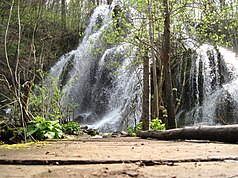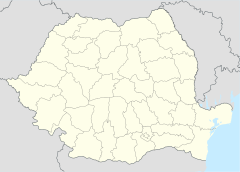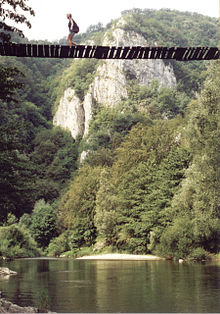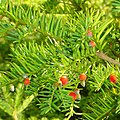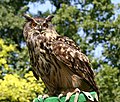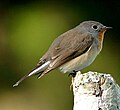Cheile Nerei-Beușnița National Park
| Cheile Nerei-Beușnița National Park | ||
|---|---|---|
| Beuşnița waterfall | ||
|
|
||
| Location: | Caraș-Severin , Romania | |
| Next city: | Caraș-Severin County , Reșița , Oravița | |
| Surface: | 362 km² | |
| Length: | 22nd | |
| Founding: | 2000 | |
The Cheile Nerei-Beuşnișa National Park (also Nera-Klamm-Beuşnița National Park , Romanian Parcul Național Cheile Nerei-Beuşnița ) is a national park in the Anina Mountains , Caraş-Severin County , in southwest Romania . It extends on an area of 36 758 hectares and consists of a karst of limestone over a length of 22 km along the Neratals with a layer height of 200 to 1116 meters at the highest peak, the Leordis peak .
history
As early as 1943, the Beușnița National Park was declared a nature reserve, followed in 1973 by the Cheile Nerei Reserve ( German Nera Gorge ). In 1990 the Semenic-Cheile Nerei-Beușnița National Park was founded. The current extent of the Cheile Nerei-Beușnița National Park was established by the Romanian Parliament by law number 5 of March 6, 2000 and published in the Official Gazette ( Monitorul Oficilal in Romanian ) number 152 of April 12, 2000. The Cheile Nerei-Beușnița National Park has existed since 1990 and was recognized as a Category II (National Park) protected area by the IUCN World Conservation Union in 2000 . In 2017, 4,292 hectares of the national park were added to the entry Primeval Beech Forests and Old Beech Forests of the Carpathian Mountains and other regions of Europe as a UNESCO World Heritage Site .
description
The sources of the Nera arise in the Semenic Mountains ( Romanian Munții Semenicului ). Northeast of the summit Piatra Nedeia springs the Nergan and southeast of Piatra Gozna the Nerganiţa . On the wooded southern slope of the Semenic Mountains, the two streams unite to form the Nera. Between Pătaș and Șopotul Nou , the Nera absorbs the water that flows over the northwest flank of the Almăj Mountains ( Romanian Munții Almăjului ). She receives ample supply at Bozovici from the Minisch ( Romanian Miniș ). After leaving the fertile Almăj Valley ( Romanian Valea Almăjului ), the Nera, cutting the Banat Karst, forces its way through a magnificent rocky world. The 22 km long gorge begins at Șopotul Nou and ends at Sasca Română . Their often meandering turns are innumerable.
Karst landscape
Steep limestone cliffs, which are called "cârşe", "pânze" or "cleanțuri", tower up on the banks of the river. The most impressive are Cârșa Căprariului , Cracul Turburii , Cârșa Șoimului , Begul Mare , Cârșa Rolului . The "cârşe" are closest in the middle section of the gorge.
A large number of grottos , caves and karst lakes can be found here. The Peştera Dubova , Peştera Voii , Gaura Hicleană and Peştera Rolului caves are some of them. Not far from the Gaura Hicleană are the Potholes La Coveţi .
Two cave lakes Ochiul Beiului ( German Meerauge ) and Lacul Dracului ( German Teufelssee ) can be found in the karst area of the Neratals. The Lacul Dracului was created by the collapse of a grotto. It is believed that it is fed underground by the Nera. The lake is 35 meters long, 18 meters wide and 9 meters deep. The Ochiul Beiului has an area of 284 square meters and is 3.6 meters deep. The Cascadele Beușniței waterfalls with a height of five meters are unique in Romania.
flora
The vegetation of the Nera Gorge National Park is extremely diverse. Here you can find endemic species as well as plants that are typical of the Mediterranean area or northern Europe . 1086 plant taxa were identified on the area of the Cheile Nerei-Beușnița National Park, including plant species with European, Central European and Euro-Asian influence.
The forest vegetation is home to trees and shrubs such as:
- English oak ( Quercus robur )
- Hornbeam ( Carpinus betulus )
- Common beech ( Fagus sylvatica )
- Common ash ( Fraxinus excelsior )
- Turkey oak ( Quercus cerris )
- Sessile oak ( Quercus petraea )
- Black Alder ( Alnus glutinosa )
- European yew ( Taxus baccata )
- Manna ash ( Fraxinus ornus )
- Tree Hazel ( Corylus colurna )
- Butcher's broom ( Ruscus aculeatus )
- Sequoia trees (Sequoioideae)
- Common lilac ( Syringa vulgaris ).
Among the herbaceous plants can be found:
- Goat strap tongue ( himantoglossum caprinum )
- Fritillaria montana
- Yellow flax ( Linum flavum )
- Spleen fern ( Ceterach officinarum )
- Cephalaria laevigata
- Monkey orchid ( Orchis simia )
- Mosquito Haendelwurz ( Gymnadenia conopsea )
- Dwarf larkspur ( Corydalis pumila )
- Gold crocus ( crocus flavus )
- Xanthium spinosum
fauna
The fauna is represented by 1890 species of invertebrates and 124 species of vertebrates.
Among the mammals can be found:
- Brown bear ( Ursus arctos )
- Red deer ( Cervus elaphus )
- Roe deer ( Capreolus capreolus )
- Wolf ( Canis lupus )
- Wild boar ( Sus scrofa )
- River otter ( lutra lutra )
- Lynx ( lynx lynx )
- Wild cat ( Felis silvestris )
- Pine marten ( Martes martes )
- Harvest shrew ( Sorex minutus )
- Blasius horseshoe bat ( Rhinolophus blasii )
- Little mouse-eared mouse ( Myotis blythii )
The bird life in the national park is very diverse and is home to both native and migratory birds:
- Golden eagle ( Aquila chrysaetos )
- Lesser Spotted Eagle ( Aquila pomarina )
- Hazel Grouse ( Bonasa bonasia )
- Eagle owl ( Bubo bubo )
- Schlangenadler ( Circaetus gallicus )
- Miniature Flycatcher ( Ficedula parva )
- Honey buzzard ( Pernis apivorus )
- Goat milker ( Caprimulgus europaeus )
- Gray woodpecker ( Picus canus )
- Ural Owl ( Strix uralensis )
- Corn Corn ( Crex crex )
- Sparrowhawk Warbler ( Sylvia nisoria )
- Red- backed shrike ( Lanius collurio )
- Ortolan ( Emberiza hortulana )
- European roller ( Coracias garrulus )
- Montagu's Harrier ( Circus pygargus )
- Middle Woodpecker ( Dendrocopos medius ).
Among the reptiles and amphibians , we should mention:
- Adder ( Vipera berus )
- Eastern green lizard ( Lacerta viridis )
- Smooth snake ( Coronella austriaca )
- Fire salamander ( Salamandra salamandra )
- Mountain Newt ( Triturus alpestris )
- Common toad ( Bufo bufo )
The following species of fish can be found in the waters of the national park :
- Stone Greens ( Gobio uranoscopus )
- Trout barbel ( Barbus meridionalis )
- Streber ( Zingel streber )
- Bitterling ( Rhodeus sericeus amarus )
Directions
- National road DN57B Oravița - Sasca Montană - Șopotu Nou - Cărbunari - Bozovici - Anina
- National road DN57B Reșița - Carașova - Anina
See also
Web links
- infocheilenerei.ro , Parcul Național Cheile Nerei-Beușnița
- nera.exploratorii.ro , Parcul Național Cheile Nerei-Beușnița
- turismland.ro , Parcul Național Cheile Nerei-Beușnița
- turism.cjcs.ro , The Cheile Nerei-Beușnița National Park
- karpatenwanderer.de , A picture book of nature: the Nera Gorge
Individual evidence
- ↑ nera.exploratorii.ro ( Memento from December 19, 2012 in the Internet Archive ), Parcul Național Cheile Nerei-Beușnița
- ↑ cdep.ro , LEGE no.5 din 6 martie 2000
- ^ Ancient and Primeval Beech Forests of the Carpathians and Other Regions of Europe, Maps . accessed on August 29, 2017.
- ↑ a b c A picture book of nature: the Nera Gorge. ( Memento from February 22, 2014 in the Internet Archive ) on eastern-images.de
- ↑ Parcul Național Cheile Nerei-Beușnița on turismland.ro
- ↑ natura2000.mmediu.ro - Cheile Nerei - Beusnita ( Memento of 29 December 2015, Internet Archive ); Retrieved June 5, 2012.
- ↑ a b c d Parcul Național Cheile Nerei-Beușnița. ( Memento from November 15, 2012 in the Internet Archive ) on infocheilenerei.ro
